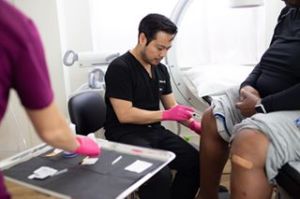The knee is a complicated formation with many elements that make it exposed to a variety of sports injuries. Most people experience minor knee issues at one point or another. Knee injuries often happen during sporting pursuits, too. As per the statistics, it has been reported that people are likely to visit the orthopedic because of knee problems.

Knee Anatomy and Working
The knee joint is the biggest joint of the body and something that can be injured easily. Two cushioning discs described as menisci separate the upper and lower bones placed in the knee to let you move. The upper leg bone (the femur) and the bones of the lower legs are attached to ligaments, tendons, and muscles. The outside of the bones is embraced by cartilage, a person that assimilates shock and gives a smooth, gliding surface. Knee injuries are the result of harm to one or more of these formations. Of the four major ligaments located in the knee, the three that are harmed the most are the anterior cruciate ligament (ACL), the medial collateral ligament (MCL), and the posterior cruciate ligament (PCL).
ACL Injury
The ACL is damaged when athletes are turning direction quickly, reducing down when running, or landing from a jump. Individuals who perform basketball, football, and soccer and those who ski are especially at high risk for ACL sprains. If this arrangement is damaged, you could need surgery to regain the full capacity of your knee. This will all be based on the severity of your damage and your exercise level.
Most of the season ACL tears are too critical to be joined back together through the stitches. The orthopedic surgeon will have to surgically repair this structure by stitches by reconstructing the ligament. Most of the time the knee doctor will use a tissue graft to heal the ligament. This graft functions as scaffolding for new ligaments to build on. Most of the time grafts are secured from the patellar tendon or the hamstring ligaments.
MCL Injury

A direct blow to the outer phase of the knee usually causes damages to the MCL. Those athletes who play football and soccer are at a greater risk. When the knee is positioned sideways and used in that particular motion, the MCL can get ripped and rise in knee pain. The swelling will happen with an MCL injury as well as further knee issues can be noticed. When the MCL is torn critically and cannot heal precisely, surgery is necessary by a knee specialist. This will involve grafting a section of the tendon to support the portions of the torn ligament to attach to. In general cases, however, these injuries can be managed without surgical interference.
PCL Injury
The PCL is most usually injured when a sportsman receives a blow to the facade of the knee. This formation can also be ripped or injured if the person makes a simple slip on the playing field. Those who engage in football and soccer are at the most elevated risk for a PCL injury. This ligament is placed in the back of the knee and attaches the femur to the shinbone (the tibia).
These were some of the examples of a knee injury and could create knee pain. If the pain persists for a long time around 26+ months, talk with your doctor.
Article Source:- https://backandpainclinic.blogspot.com/2021/03/how-do-i-know-what-type-of-knee-injury.html

